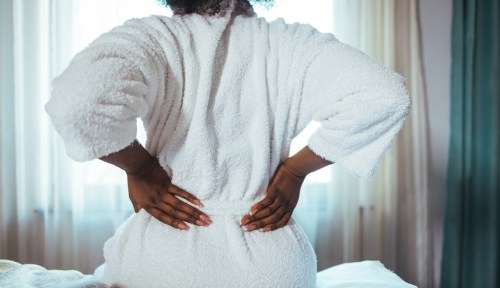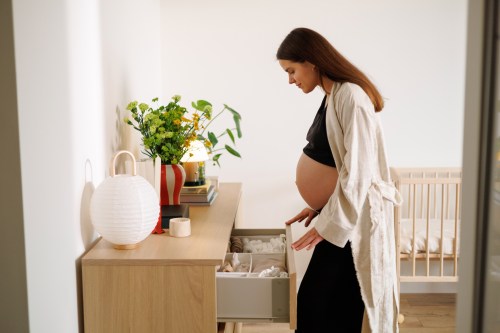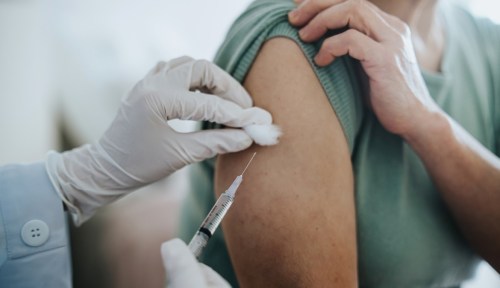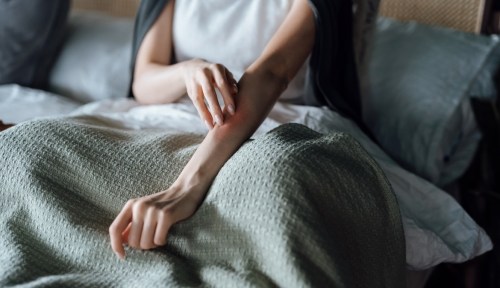Things that are the worst: your fave coffee shop running out of oat milk, missing your flight because the security line was so long, and painful periods with unexpected period symptoms.
Experts in This Article
board-certified OB/GYN based in Maryland
OB/GYN and co-founder of DeoDoc Intimate Skincare
And if the cramping (including anus cramps), bleeding, and mood shifts weren’t enough to make us all dread that time of the month, some of us are blessed with an additional *fun* (read: not fun) period side effect: PMS back pain.
What causes PMS back pain?
There are a few different things that can cause PMS back pain, from mild to more severe concerns. These include:
1. Overactive muscles contracting
According to the Virginia Spine Institute, back pain that comes on during menstruation is generally caused by the same thing that causes your cramps: overactive muscles. Thank the chemicals called prostaglandins, which tell your uterine muscles to contract (and thus shed the built-up uterine lining) during your period, per the Mayo Clinic. If your body goes overboard making prostaglandins, those contracting muscles can cause some major cramping—creating pain that can radiate to your lower back. (Hello, back pain.)
“These conditions can be categorized as primary and secondary dysmenorrhea,” says Gunvor Ekman Ordeberg, MD, PhD, OB/GYN and co-founder of DeoDoc Intimate Skincare.
“Primary if the pain is only brought on by the body’s natural menstrual cycle process, and secondary if there are other underlying conditions that are causing pain in the body, but the inflammation in the body during menstruation is amplifying it,” says Dr. Ekman Ordeberg.
2. Underlying health conditions
Adrienne Potts, MD, FACOG, an OB/GYN specializing in family planning and preventative care, says there are some other factors that can cause PMS back pain. For example, she says having a retroverted (aka, tilted) uterus may make some women get cramping in the lower back instead of (or in addition to) the abdomen. And there are other health conditions, like endometriosis or uterine fibroids, that can also contribute to a menstrual backache and cramping.
“It can be hard to disentangle the cause without a more in-depth examination, particularly in separating the more ‘typical’ pain that women commonly have from pain that could suggest a secondary condition,” Dr. Potts says. She says women should check in with their OB/GYN if they get hormonal back pain or any other menstrual symptoms that regularly interfere with their daily activities or are not adequately managed with at-home remedies (more on those in a sec).
3. Uterine fibroids
In most cases, uterine fibroids sound more severe than they actually are. According to the Mayo Clinic, they are noncancerous, benign tumors that typically grow on and in the uterus during childbearing years. While they are generally harmless, they can still cause menstrual cramps and back pain.
Fibroids go largely undetected until a pelvic exam is done. If you do have symptoms, they usually include the following, per the Mayo Clinic:
- Back pain
- Heavy periods
- Pelvic pain and pressure
- Leg pain
- Frequent urination
- Constipation
And just because fibroids are typically considered harmless, doesn’t mean they should be ignored. If fibroids are too large, they might need to be surgically removed or treated with medication.
4. Endometriosis
Endometriosis is a chronic disease that can have painful lifelong symptoms and currently has no cure. The cause of it is also unclear, making it even more difficult to diagnose and manage. Endometriosis happens when tissue from the inner lining of the uterus—called the endometrium—grows in another location, according to the World Health Organization. The endometrial tissue can appear on the outer surface of the uterus or nearby organs, such as the ovaries, bladder, or bowel.
Symptoms vary depending on where the endometrial tissue is located, but pain in the lower back or lower abdomen is common with endometriosis, per the Mayo Clinic.
5. Pelvic inflammatory disease (PID)
Pelvic inflammatory disease, also known as PID, is an infection located in the reproductive organs like the uterus, vagina, and ovaries, per the Centers for Disease Control and Prevention (CDC). It’s typically caused by sexually transmitted infections (STIs) and can lead to symptoms like lower back pain during PMS, abdominal pain, abnormal vaginal discharge, and fever.
Thankfully, this is a totally treatable condition, but it’s best to get it quickly diagnosed and treated. Delayed treatment can lead to serious complications (like an abscess or sepsis, which would require hospitalization for IV antibiotics) and long-term problems like infertility and chronic pelvic pain, according to the Cleveland Clinic.
Are certain people at higher risk for PMS back pain?
Unfortunately, underlying conditions can make PMS back pain more painful, making some people more susceptible to it than others.
“If you suffer from conditions such as endometriosis, pelvic inflammatory disease (PID), or uterine fibroids, the pain you feel could be worse than that of people without these conditions,” Dr. Ekman Ordeberg says.
Other reasons you could be at a higher risk for dysmenorrhea (i.e., painful periods) in general include: smoking, drinking alcohol during your period, never having been pregnant, and starting your period before age 11, per Johns Hopkins Medicine.
How to treat your PMS back pain
Though it may feel like there’s no way around the insane back aches before and during your period, there are actually a lot of things you can do to help deal with the pain. Dr. Potts recommends starting out with over-the-counter (OTC) medications and home remedies—that’s generally pretty effective for most people. Here are some of the best options:
1. Non-steroidal anti-inflammatories (NSAIDs)
A large July 2015 study in the Cochrane Database of Systematic Reviews1 shows that NSAIDs (the fancy name for OTC pain-relievers like ibuprofen and aspirin) are super effective in relieving period-related pain. But side effects—which can range from benign (indigestion, drowsiness) to much more serious (increased risk of a heart attack or stroke)—are also common with prolonged use of these drugs, per the Cleveland Clinic. If you find that you need to use NSAIDs for more than 10 days, talk to your doctor.
2. Heat therapy
Dr. Potts and Dr. Ekman Ordeberg both recommend heating pads to help soothe low-back pain and abdominal cramping before and during your period. And it’s pretty legit: A November 2018 study in Science Reports2 showed that applying heat locally (so in this case, your back) can decrease muscle tension and relax your muscles to reduce pain.
“Heat can temporarily block the brain’s pain receptors which allow some relief while it is applied,” Dr. Ekman Ordeberg says. Try using a heating pad or hot water bottle for pelvic and back pain relief during menstruation.
3. Yoga
Many women swear by the calming, healing powers of yoga to alleviate pain and bloating while also inducing all the tranquil Zen feels we could totally use during that time of the month. Research from a December 2016 review in Alternative & Integrative Medicine3 found that doing yoga was associated with reduced period pain (both how intense it is and how long it lasts), but more clinical trials are needed. So go ahead and take that hot yoga class. Or, try the flow below for relieving menstrual cramps.
4. Aerobic exercise
Okay, working out is probably the last thing on your mind when you have cramps and PMS back pain, but a small January 2018 study in the Journal of Education and Health Promotion4 found that eight weeks of aerobic exercise three times a week helped alleviate menstrual pain. Yet another reason to keep up with a consistent workout routine.
5. Supplements and herbal remedies
For centuries, people have experimented with a variety of alternative treatments for cramps, including supplements and herbs for PMS. A March 2016 study in the Cochrane Database Systematic Reviews5 suggests that thiamine (vitamin B1), vitamin E, toki-shakuyaku-san (a Japanese herbal remedy), and magnesium can help with period cramps and pain.
Just be sure to talk with your doctor before trying herbal remedies to make sure that they won’t interfere with other meds or treatments you’re taking. Your doctor can also help you find the best PMS supplements.
Can you prevent PMS back pain?
Sadly, there aren’t many ways to prevent PMS back pain. It’s often a natural symptom of the body’s menstrual cycle process. But there are plenty of strategies to lessen it so it’s tolerable, as mentioned above.
“Some studies show that PMS back pain can be lessened with a proper exercise and nutrition program. We also recommend different methods of hormonal birth control to help regulate the hormones and body during the entire menstrual cycle,” Dr. Ekman Ordeberg says.
When to see a doctor about period-related back pain
If OTC medication and home remedies aren’t doing the trick, it’s time to visit your doctor. “If women aren’t able to achieve relief through these measures, they should schedule an appointment to rule out secondary causes of pain and consider alternative treatments, such as hormonal contraceptives,” Dr. Potts says. And you should especially see your doctor if your day-to-day routine is being rudely interrupted by pain.
“If you find that your back pain is severe or it is interfering with your everyday life, then I would recommend seeing your doctor,” Dr. Ekman Ordeberg says.
As mentioned earlier, there might be another condition at play that requires more or different treatments than a few Advil and yoga stretches.
FAQ
How many days before your period does back pain start?
PMS back pain often starts several days before your period begins, but should go away within four days of your period, per the Mayo Clinic. That said, everyone is different; your back pain may last longer (or ease up sooner) than what’s considered the average.
Can PMS cause upper back pain?
According to the Mayo Clinic, it is possible to have lower and upper back pain before your period. But these PMS symptoms shouldn’t last for long. Most often, if it’s related to PMS, you can expect the pain to go away once your period starts. Using a heating pad, taking a bath, or even getting a massage could help period back pain, no matter the location.
Does exercise help period back pain?
Yes, it can! Exercise is a great tool for managing PMS discomfort, and relieving back pain before and during your period. It doesn’t have to be intense—try 30 minutes of light exercise, like gentle yoga, a walk, or other specific exercises for PMS relief. Not only can exercise help with PMS back pain, but it can also help boost your mood and relieve other symptoms caused by premenstrual changes.
—medically reviewed by Andrea Braden, MD, OB/GYN
Marjoribanks, Jane et al. “Nonsteroidal anti-inflammatory drugs for dysmenorrhoea.” The Cochrane database of systematic reviews vol. 2015,7 CD001751. 30 Jul. 2015, doi:10.1002/14651858.CD001751.pub3
↩︎Jo, Junyoung, and Sun Haeng Lee. “Heat therapy for primary dysmenorrhea: A systematic review and meta-analysis of its effects on pain relief and quality of life.” Scientific reports vol. 8,1 16252. 2 Nov. 2018, doi:10.1038/s41598-018-34303-z
↩︎Ko, Hyun Nam, et al. “Effects of yoga on dysmenorrhea: A systematic review of randomized controlled trials.” Alternative & Integrative Medicine, vol. 05, no. 04, 2016, https://doi.org/10.4172/2327-5162.1000226.
↩︎Dehnavi, Zahra Mohebbi et al. “The Effect of aerobic exercise on primary dysmenorrhea: A clinical trial study.” Journal of education and health promotion vol. 7 3. 10 Jan. 2018, doi:10.4103/jehp.jehp_79_17
↩︎Pattanittum, Porjai et al. “Dietary supplements for dysmenorrhoea.” The Cochrane database of systematic reviews vol. 3,3 CD002124. 22 Mar. 2016, doi:10.1002/14651858.CD002124.pub2
↩︎
Sign Up for Our Daily Newsletter
Get all the latest in wellness, trends, food, fitness, beauty, and more delivered right to your inbox.
Got it, you've been added to our email list.











